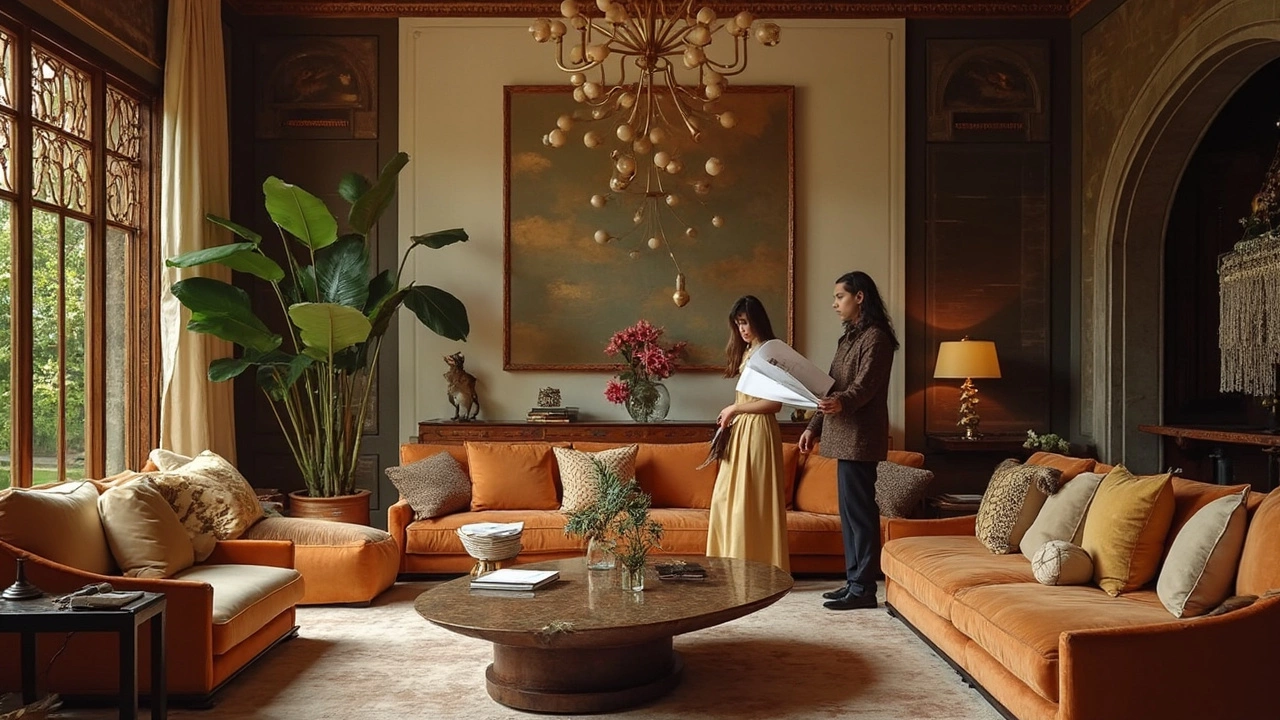Imagine walking into a place where everything feels just right—nothing is cookie-cutter, nothing screams “trendy but cheap.” That’s the world top-tier interior designers live in. Their job isn’t just about picking pricey furniture or throwing in a few gold accents. High end designers see beyond what’s there, shaping every inch of a room so it feels both luxurious and genuinely personal.
If you think it’s all about brand names or prestige, you’re missing the full picture. These designers get deep into how you live—like, do you want a serious home office or a movie den that doesn’t feel like a cave? They’ll work with craftspeople, source rare finishes, and sketch out pieces literally made for your home, not just your zip code. And yeah, they’ll be honest if you’re about to make a mistake that screams “expensive regret.”
- Defining High End Design
- The Real Work Behind the Scenes
- Signature Moves and Custom Details
- How to Work With a High End Designer
- Spotting True Luxury: Tips and Red Flags
Defining High End Design
People toss around the word “luxury” so much it nearly loses its meaning. But when you talk about high end interior design, it’s not just about price tags—it’s how every inch of a space feels intentional, unique, and truly tailored. The difference is real: Regular designers make things look nice. High end designers create spaces so good they actually change how you feel at home.
A high end interior designer always starts by getting personal. That means understanding your daily routines, hobbies, even how you like to unwind after work. Then, they connect you to a world most folks never see—think Italian marble that takes six months to ship, or hardware custom-made by a local artisan. No shortcuts, no generic catalog orders.
Here’s what really separates them:
- Customization: Furniture fit just for your room, not mass-produced.
- Expert Sourcing: From antique markets in Paris to family-run workshops, sourcing is personal and global.
- Attention to Detail: Everything from hand-sewn drapes to the way sunlight hits your reading chair.
- Project Management: Coordinating a team of architects, builders, and specialists while sticking to timelines and budgets.
Want some proof of how much work goes into all this? The American Society of Interior Designers reported in 2024 that a luxury home project easily takes 6 to 18 months, and costs can range between $200 and $500 per square foot.
| Level | Timeline | Cost per square foot |
|---|---|---|
| Standard Design | 3-6 months | $50 - $150 |
| High End Design | 6-18 months | $200 - $500 |
It’s not just about splurging. High end design means making choices so thoughtful that even the smallest details make your space one-of-a-kind—and totally yours.
The Real Work Behind the Scenes
If you ask anyone who’s used a high end interior designer, they’ll tell you the design magic happens way before the first paint swatch hits the wall. These designers don’t simply stroll through showrooms or scroll Pinterest for ideas. Instead, the real grind kicks off with hours of research, site visits, and deep dives into how you use every space in your home.
First, they gather details. Think in-depth interviews, not just quick chats about color. Designers will measure out each room, check sunlight patterns, and even look at how you entertain or work from home. The goal isn't just good looks—it's making the space truly work for you (and last, so you’re not redoing this every few years).
Behind the scenes, there’s a ton of collaboration. Designers team up with architects, contractors, and specialty artisans—sometimes even flying in someone to build a custom table or restore a vintage chandelier. Every wire, light switch, and seam is planned way before installation day. And forget just picking things off a shelf; high end projects use software for 3D layouts, mood boards, and detailed drawings to make sure everything fits and flows.
Budgets and timelines here aren’t about rule-of-thumb guessing. Expect spreadsheets that track every detail, from marble slabs cut to size, to rare hardware flown in from Italy. Designers usually keep their clients in the loop with regular updates, site walkthroughs, and samples to touch and feel.
They also handle headaches quietly. If something goes sideways—like Italian tiles getting held at customs—they’re on the phone sorting it out, so you’re not losing sleep over shipping delays. Their job is to fight fires so you see only the finished product—every corner, cushion, and cabinet exactly as planned.

Signature Moves and Custom Details
So, what exactly shows that you’ve hired a real high end interior designer? It’s all in the details. These pros aren’t just filling a room—they’re making it yours, with stuff you won’t find in your neighbor’s house or even at top retail stores.
One standout move is custom millwork. It’s not unusual for high end designers to have custom cabinets or libraries built from scratch. They’ll choose the wood, design the finish, and make sure the proportions fit your space, and your vibe. In New York penthouses, it’s not rare to see hidden doors, built-in bars, or hand-carved paneling that turns a wall into art.
Don’t overlook rare materials, either. We’re not just talking Carrara marble countertops—think custom inlaid floors with walnut and brass, velvet couches sewn by small-batch European studios, or wallcoverings painted by hand. Some luxury designers even fly in craftspeople for one-off finishes, like Venetian plaster or gold leaf ceilings. For reference, London-based designer Martin Kemp has used Siberian tigers’ patterns (all ethical and faux, don’t worry) as inspiration for custom rugs—one rug, one home, never repeated.
Tech upgrades are another favorite trick. High end interiors often hide serious technology: invisible speakers, motorized blackout shades, and lighting you control with your phone or a voice assistant. The whole point is, the tech doesn’t show off—it just works perfectly and disappears into the background.
Stuff like monogrammed hardware or personalized wine cellars also comes up a lot. Designers might even have custom-made door handles or build a pet nook that doubles as storage. These moves aren’t just to show off. They solve real-life needs in ways that look totally seamless, not tacked on as an afterthought.
| Popular Custom Features | Typical Cost Range (USD) |
|---|---|
| Bespoke cabinetry | $10,000 - $50,000+ |
| Hand-crafted lighting | $3,000 - $25,000 |
| Custom stone or wood floors | $20,000 - $100,000+ |
| High-tech integration (AV, smart shades) | $5,000 - $50,000 |
| Unique wall treatments (murals, Venetian plaster) | $5,000 - $40,000 |
If you’re ever in doubt, ask a designer what’s been totally made or tailored for a project. The best ones can list half a dozen things without blinking. The result is a space that actually feels like you—even if you had no idea those details existed before.
How to Work With a High End Designer
Ready to level up your space? Working with a high end interior designer is more about making your ideas doable than handing over total control. Here’s what the process actually looks like, without the smoke and mirrors.
It kicks off with an in-depth chat—sometimes hours, sometimes days—where the designer wants to know how you’ll use every room, your non-negotiables, and what makes you tick. This isn’t a quick Q&A. Expect questions about your habits, pets, even how you store shoes. The more honest and detailed you are, the better the outcome.
- Share Inspiration—But Stay Open: Bring photos, clippings, or Pinterest boards, but be ready to hear expert opinions about what will actually work in your space.
- Discuss Your Budget Upfront: No designer loves surprises here. High end projects usually start around $200 per square foot, but can go much higher with custom work or rare materials.
- Sign a Contract: You’ll see timelines, payment schedules, and deliverables in writing. Most designers ask for a retainer before moving forward.
Expect to have regular meetings or Zoom calls for feedback and big decisions. Some designers use 3D walk-throughs, so you can "walk" through your future home long before it's done. If you hate something or see a problem, say it now—changes late in the project mean delays and more costs.
Here’s a quick look at what a typical project involves:
| Step | What Happens | Typical Timeframe |
|---|---|---|
| Consultation | Personal interviews, site visit, mood boards | 1-4 weeks |
| Design Development | Concepts, drawings, material selections | 2-8 weeks |
| Procurement | Ordering furniture, custom pieces, finishes | 4-16 weeks |
| Installation | Final setup, styling, client walkthrough | 1-4 weeks |
Be honest about your daily life and quirks. Designers can hide tech, add secret storage, or make sure your dog’s bed doesn’t spoil the vibe. If you travel a lot, tell them—they can keep the project on track while you’re gone. And always ask for weekly updates so you’re never in the dark about what’s next.
The best tip? Treat this like a partnership, not just a transaction. Good communication cuts down on mistakes, stress, and those legendary blown budgets everyone dreads. Remember: the right designer turns your space into a version of you—just with way better style.

Spotting True Luxury: Tips and Red Flags
It’s easy to get caught up in buzzwords, but real high end interior design has little to do with flaunting expensive logos. There are clear signs that separate true luxury from clever marketing.
- Personalization Wins: Custom pieces designed for the space—not just picked from a showroom—are a solid indicator. Ask about one-of-a-kind features; true pros rarely repeat the same look twice.
- Material Matters: Genuine quality shows in the details. Think solid woods, hand-stitched leather, real marble. If the stone looks suspiciously thin or the wood is veneered particleboard, it’s a no-go.
- Workmanship: Top-notch designers collaborate with skilled trades. Check door hinges, cabinet finish, and built-ins. Even the back of a closet or the stitching on a chair reveals how much someone cares about quality.
- Planning Over Impulse: You’ll see detailed plans—mood boards, samples, layouts—before anything starts. If all you get is a mood board full of out-of-stock items, that’s a red flag.
- Comfort Isn’t Ignored: Luxury doesn’t mean stiff or showy. The space should make your life easier and reflect your routines. You should never worry about ruining a sofa with daily use.
A real high end interior designer pushes for details like double insulation for soundproofing, hidden outlets, or climate-controlled wine storage—stuff that’s invisible at first glance, but life-changing once you move in.
| Quality Sign | What to Check |
|---|---|
| Custom-built furniture | Ask for maker info or sketches |
| Top-grade materials | Inspect thickness, finish, hardware |
| Project management | See actual schedules, check-ins, updates |
| Hidden functionality | Check for clever storage and tech integration |
On the flip side, watch out for red flags. If your designer’s portfolio looks like it was shot on the same day, or every project has nearly identical furniture, it’s worth asking questions. Markups are normal in luxury, but if you’re getting mass-market goods dressed up as "exclusive," it’s time to walk away.

